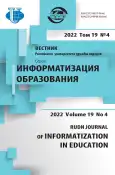Онлайн-инструменты визуальной коммуникации для совместного обучения и установления контакта между участниками
- Авторы: Осиповская Е.А.1, Лукач Д.2
-
Учреждения:
- Российский университет дружбы народов
- Centre of Competence for EPLAN Certifications
- Выпуск: Том 19, № 4 (2022)
- Страницы: 351-359
- Раздел: ВЛИЯНИЕ ТЕХНОЛОГИЙ НА РАЗВИТИЕ ОБРАЗОВАНИЯ
- URL: https://journal-vniispk.ru/2312-8631/article/view/321298
- DOI: https://doi.org/10.22363/2312-8631-2022-19-4-351-359
- ID: 321298
Цитировать
Полный текст
Аннотация
Постановка проблемы . Цель исследования заключается в изучении вопроса трансформации традиционных подходов совместного обучения под влиянием новой цифровой среды, а также способов внедрения групповых онлайн-занятий, в частности игр, ориентированных на налаживание взаимодействия и создания позитивной атмосферы на занятии (от англ. icebreakers). Методология. В качестве платформ для групповой работы авторы выбрали Miro и Mural, которые позволяют пользователям коммуницировать в онлайн-среде и настраивать рабочее пространство в соответствии со своими потребностями. Они сравнили и протестировали платформы по шести категориям: тарифные планы, интерфейс, шаблоны, интеграция с другими программами, кастомизация, коммуникация с участниками. Результаты. Сделаны выводы, что Miro имеет значительно больший выбор шаблонов, приложений и возможностей для интеграции других приложений. Интерфейс платформы отличается продуманной визуальной согласованностью элементов дизайна и в целом представляет собой отличный пользовательский опыт. Mural же предлагает больше возможностей для упрощения и оптимизации работы, что, несомненно, делает его эффективным инструментом. Но если вопрос цены виртуальной доски имеет решающее значение, то Mural в этом отношении является более целесообразным выбором. Кроме того, рассмотрены подходы к организации icebreaker-игр во время оналйн-занятий в Miro и Mural. Предложено несколько упражнений: создать своего персонажа, случайные вопросы, головоломка, карта мира, пять общих вещей, две лжи - одна правда, фотография стола. Заключение. Показано, что онлайн-доски Miro и Mural эффективно реализуют коллаборативные активности в онлайн-среде.
Ключевые слова
Об авторах
Елизавета Андреевна Осиповская
Российский университет дружбы народов
Автор, ответственный за переписку.
Email: osipovskaya-ea@rudn.ru
ORCID iD: 0000-0002-4192-511X
кандидат филологических наук, доцент кафедры массовых коммуникаций, филологический факультет
Российская Федерация, 117198, Москва, ул. Миклухо-Маклая, д. 6Душко Лукач
Centre of Competence for EPLAN Certifications
Email: lukac.d@eplan.de
ORCID iD: 0000-0002-0543-4129
руководитель отдела образования компании EPLAN GmbH & Co.
10B KG Wacholderweg, Зигбург, 53721, Федеративная Республика ГерманияСписок литературы
- Timonen P, Ruokamo H. Designing a preliminary model of coaching pedagogy for synchronous collaborative online learning. Journal of Pacific Rim Psychology. 2021. https://doi.org/10.1177/1834490921991430
- Väätäjä JO, Ruokamo H. Conceptualizing dimensions and a model for digital pedagogy. Journal of Pacific Rim Psychology. 2021. https://doi.org/10.1177/1834490921995395
- Niemi H. AI in learning: preparing grounds for future learning. Journal of Pacific Rim Psychology. 2021. https://doi.org/10.1177/18344909211038105
- Mu X, Xu K, Chen Q, Du F, Wang Y, Qu, H. MOOCad: visual analysis of anomalous learning activities in massive open online courses. EuroVis. Short Papers. Zurich; 2019. p. 91-95.
- Okubo F, Shimada A, Yin C, Ogata H. Visualization and prediction of learning activities by using discrete graphs. Proceedings of the 23rd International Conference on Computers in Education (30 November - 4 December 2015). Hangzhou; 2015. p. 739-744.
- Quan G, Gu X. Visualization forms in the cross-cultural collaborative activities of design and development of a digital resource for education. Journal of Educational Computing Research. 2017;56(3):439-463. https://doi.org/10.1177/0735633117708336
- Kui X, Liu N, Liu O, Liu J, Zeng X, Zhang C. A survey of visual analytics techniques for online education. Visual Informatics. 2022. https://doi.org/10.1016/j.visinf.2022.07.004.
- Lamia H. Collaborative learning and collaborative visualization. Available from: https://wikimemoires.net/2022/03/collaborative-learning-and-collaborative-visualization/ (accessed: 11.09.2022).
- Chen FS, Ke HS, Chen YC. Online learning as a panacea? An empirical study to discuss problem-based cooperative learning in Taiwan. International Journal of Emerging Technologies in Learning. 2020;15(18):251-259. https://doi.org/10.3991/ijet.v15i18.15079
- Rahman A, Ahmar A, Rusli R. The influence of cooperative learning models on learning outcomes based on students’ learning styles. World Transactions on Engineering and Technology Education. 2016;14(3):425-430. https://doi.org/10.26858/wtetev14i3y2016p6425430
- Scager K, Boonstra J, Peeters T, Vulperhorst J, Wiegant F. Collaborative learning in higher education: evoking positive interdependence. CBE Life Sciences Education. 2016;15(4):1-9. https://doi.org/10.1187/cbe.16-07-0219
- Zhang L, Basham JD, Yang S. Understanding the implementation of personalized learning: a research synthesis. Educational Research Review. 2020;31:100339. https://doi.org/10.1016/j.edurev.2020.100339
- Lopez M, Gerardo Carrillo Arriaga J, Nigenda Álvarez JP, Treviño González R, Elizondo-Leal JA, Valdez-García JE, Carrión B. Virtual reality vs traditional education: is there any advantage in human neuroanatomy teaching? Computers & Electrical Engineering. 2021;93:107282. https://doi.org/10.1016/j.compeleceng.2021.107282
- Alvarez C, Salavati S, Nussbaum M, Milrad M. Collboard: fostering new media literacies in the classroom through collaborative problem solving supported by digital pens and interactive whiteboards. Computers & Education. 2013;63:368-379, https://doi.org/10.1016/j.compedu.2012.12.019
- Brandao MA, Hagy S, Thuvander L. Collaborative pedagogy for co-creation and community outreach: an experience from architectural education in social inclusion using the Miro tool. In: Raposo D, Martins N, Brandão D. (eds.) Advances in Human Dynamics for the Development of Contemporary Societies. AHFE; 2021.
Дополнительные файлы









